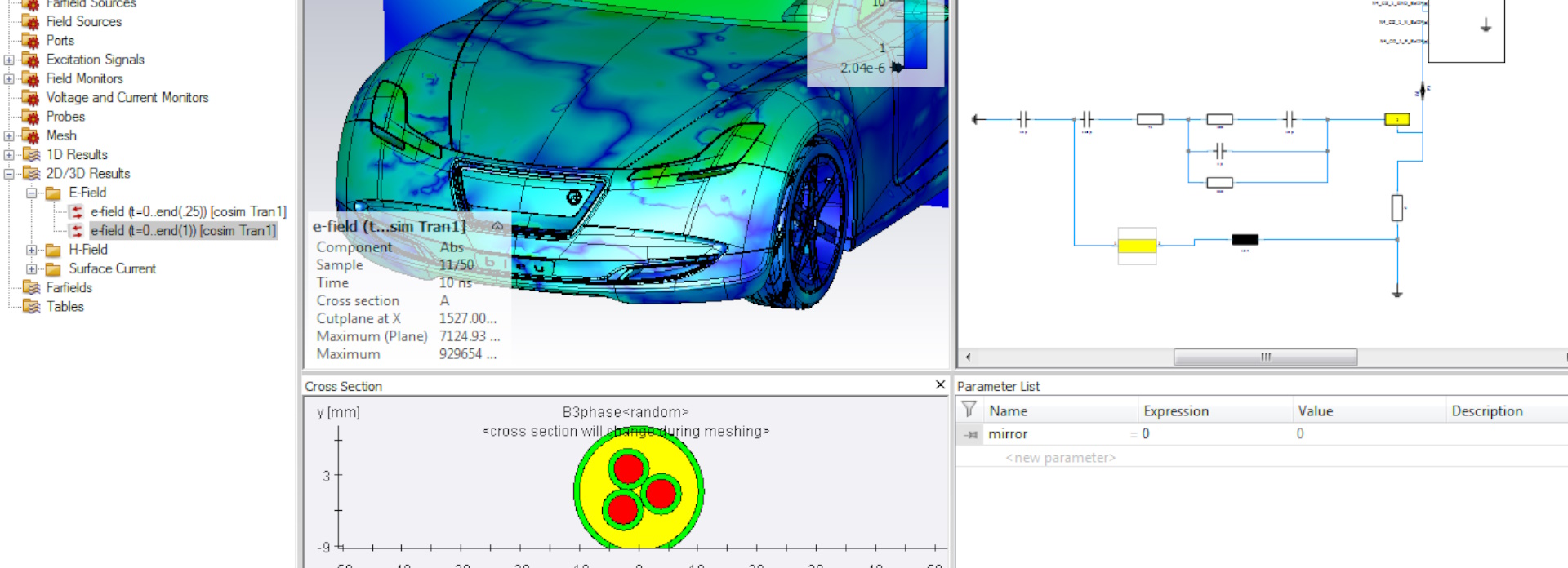
Introduction: CST Studio Suite is a leading software package for electromagnetic simulation and analysis, used by engineers, researchers, and designers to model and optimize a wide range of electromagnetic systems and devices. From antennas and microwave circuits to motors and sensors, CST Studio Suite provides powerful simulation tools and advanced solvers for accurately predicting electromagnetic behavior and performance. In this extensive guide, we’ll explore the intricacies of modeling electromagnetic systems in CST Studio Suite, covering everything from setting up simulation models to analyzing results and optimizing designs.
Section 1: Introduction to CST Studio Suite 1.1 Understanding Electromagnetic Simulation: Gain insight into the importance of electromagnetic simulation in engineering and scientific research, and its role in designing and optimizing electromagnetic systems. Explore the capabilities of CST Studio Suite for simulating electromagnetic fields, including static and time-varying electric fields, magnetic fields, and electromagnetic waves. Understand the advantages of numerical simulation techniques for solving Maxwell’s equations in complex geometries and material configurations.
1.2 Installing CST Studio Suite and Getting Started: Before you can start modeling electromagnetic systems in CST Studio Suite, you’ll need to download and install the software on your computer. CST Studio Suite is available for Windows and Linux platforms and can be obtained from the CST website. Launch CST Studio Suite and familiarize yourself with the user interface, including the project manager, model editor, solver setup, and result viewer, where you’ll create and analyze simulation models.
Section 2: Setting up Electromagnetic Simulation Models 2.1 Creating Geometry and Mesh: Start by creating the geometry of your electromagnetic simulation model using the model editor in CST Studio Suite. Learn how to import CAD (Computer-Aided Design) geometries or create simple geometries from scratch using primitive shapes and boolean operations. Generate a mesh for the geometry to discretize the domain into smaller elements for numerical simulation. Explore meshing techniques, such as tetrahedral and hexahedral meshing, and adjust mesh parameters for optimal simulation accuracy and efficiency.
2.2 Defining Materials and Boundary Conditions: Define the materials and boundary conditions of your electromagnetic simulation model in CST Studio Suite to represent the physical environment accurately. Specify material properties such as permittivity, permeability, conductivity, and dielectric loss for different regions of the simulation domain. Set up boundary conditions, such as electric/magnetic boundary conditions, radiation boundary conditions, and symmetry planes, to model the behavior of electromagnetic fields at domain boundaries.
Section 3: Solving Electromagnetic Field Equations 3.1 Selecting Solver Types and Settings: Choose the appropriate solver type and settings in CST Studio Suite to solve Maxwell’s equations and simulate electromagnetic fields accurately. CST Studio Suite offers a variety of solver types, including frequency domain solvers, time domain solvers, and eigenmode solvers, for different simulation scenarios. Configure solver settings such as frequency range, time step, convergence criteria, and numerical discretization methods for optimal simulation performance and accuracy.
3.2 Simulating Electromagnetic Fields: Perform electromagnetic field simulations in CST Studio Suite by solving Maxwell’s equations numerically for the specified geometry, materials, and boundary conditions. Explore simulation techniques such as frequency domain simulation, transient simulation, and eigenmode analysis for different electromagnetic phenomena. Use CST Studio Suite’s advanced solvers, such as the finite integration technique (FIT), finite element method (FEM), and integral equation method (IEM), to accurately model electromagnetic fields in complex geometries and material configurations.
Section 4: Analyzing Simulation Results 4.1 Visualizing Electromagnetic Fields: Visualize the results of electromagnetic field simulations in CST Studio Suite using a variety of visualization tools and techniques. Generate contour plots, vector plots, field overlays, and cut planes to visualize electric and magnetic field distributions, field strengths, and field patterns in the simulation domain. Customize visualization settings, such as colormap, field components, field lines, and animation options, to enhance the clarity and readability of simulation results.
4.2 Extracting Field Parameters and Performance Metrics: Extract quantitative data from electromagnetic field simulations in CST Studio Suite using post-processing tools and data analysis features. Calculate key performance metrics, such as S-parameters, scattering parameters, impedance, and radiation patterns, from simulation results to evaluate the performance of electromagnetic systems and devices. Use field probes, monitors, and field calculators to measure field parameters at specific locations in the simulation domain and analyze their impact on system behavior.
Section 5: Advanced Techniques and Applications 5.1 Modeling Antennas and RF Components: Explore advanced techniques for modeling antennas, RF (Radio Frequency) components, and microwave circuits in CST Studio Suite. Learn how to design and simulate various types of antennas, such as dipole antennas, patch antennas, horn antennas, and array antennas, for wireless communication and radar applications. Model RF components, such as filters, couplers, amplifiers, and transmission lines, using lumped element models, distributed element models, or electromagnetic simulations, depending on the frequency range and complexity of the components.
5.2 Optimizing Electromagnetic Designs: Utilize CST Studio Suite for design optimization and parametric studies to explore the sensitivity of electromagnetic systems to design parameters and operating conditions. Define design variables, constraints, and objectives for optimization problems and use optimization algorithms, such as gradient-based and genetic algorithms, to find optimal design solutions. Perform parametric sweeps and sensitivity analyses to study the effects of variations in input parameters on simulation results and system performance.
Conclusion: CST Studio Suite offers a comprehensive and versatile platform for modeling electromagnetic systems and analyzing electromagnetic fields in engineering and scientific applications. By mastering the fundamentals of electromagnetic modeling in CST Studio Suite and exploring advanced techniques for model setup, solver configuration, result analysis, and optimization, you can gain valuable insights into the behavior of electromagnetic systems and devices. Whether you’re designing antennas, RF circuits, sensors, or electromagnetic actuators, CST Studio Suite provides the tools and capabilities you need to simulate, analyze, and optimize electromagnetic systems with confidence and efficiency. With practice, experimentation, and continuous learning, you can become proficient in using CST Studio Suite to tackle complex electromagnetic challenges and drive innovation in your engineering projects.